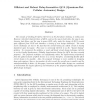Free Online Productivity Tools
i2Speak
i2Symbol
i2OCR
iTex2Img
iWeb2Print
iWeb2Shot
i2Type
iPdf2Split
iPdf2Merge
i2Bopomofo
i2Arabic
i2Style
i2Image
i2PDF
iLatex2Rtf
Sci2ools
DFT
2006
IEEE
2006
IEEE
Efficient and Robust Delay-Insensitive QCA (Quantum-Dot Cellular Automata) Design
The concept of clocking for QCA, referred to as the four-phase clocking, is widely used. However, inherited characteristics of QCA, such as the way to hold state, the way to synchronize data flows, and the way to power QCA cells, make the design of QCA circuits quite different from VLSI and introduce a variety of new design challenges. The most severe challenges are due to the fact that the overall timing of a QCA circuit is mainly dependent upon its layout. This issue is commonly referred to as the "layout=timing" problem. To circumvent the problem, a novel self-timed circuit design technique referred to as the Locally Synchronous, Globally Asynchronous Design for QCA has been recently proposed. The proposed technique can significantly reduce the layout-timing dependency from the global network of QCA devices in a circuit; therefore, considerably flexible QCA circuit design is be possible. Also, the proposed technique is more scalable in designing large-scale systems. Since...
DFT 2006 | Power Qca Cells | Qca Circuit | QCA Circuit Design | VLSI |
| Added | 22 Aug 2010 |
| Updated | 22 Aug 2010 |
| Type | Conference |
| Year | 2006 |
| Where | DFT |
| Authors | Minsu Choi, Myungsu Choi, Zachary D. Patitz, Nohpill Park |
Comments (0)

